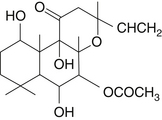Chapter 80 Coleus forskohlii
Coleus forskohlii (family: Labiatae)
Synonyms: Coleus barbatus, Plectranthus barbatus, P. forskohlii
 Chemical Composition
Chemical Composition
The primary chemical of clinical interest contained in C. forskohlii is the diterpine forskolin (Figure 80-1). In 1974, forskolin was discovered during a large-scale screening of medicinal plants by the Indian Central Drug Research Institute. The screening revealed the presence of a hypotensive and spasmolytic component, which was initially named coleanol.1 Additional investigation determined the exact chemical structure, and the name was changed to forskolin. From 1981 to 2010, forskolin was used in more than 15,000 in vitro and in vivo experimental studies designed to better understand the cellular processes governed by cyclic adenosine monophosphate (cAMP). Although most of these studies used this isolated constituent, there is evidence that other components within the plant extract may have biological activity, as well as enhance the absorption and action of forskolin.
 Pharmacology
Pharmacology
As noted in a landmark experiment in 1981, the basic mechanism of action of forskolin is the activation of adenylate cyclase, which increases cAMP in cells.2 cAMP is perhaps the most important cell-regulating compound. Once formed, it activates many other enzymes involved in diverse cellular functions.3
The physiologic and biochemical effects of a raised intracellular cAMP level include the following:
• Inhibition of platelet activation and degranulation
• Inhibition of mast cell degranulation and histamine release
• Increased force of contraction of heart muscle
• Relaxation of the arteries and other smooth muscles
Forskolin possesses additional mechanisms of action independent of its ability to directly stimulate adenylate cyclase and cAMP-dependent physiologic responses.4 Specifically, forskolin was shown to inhibit a number of membrane transport proteins and channel proteins through a mechanism that did not involve the production of cAMP. The result was a transmembrane signaling that resulted in activation of other cellular enzymes. Research is under way to determine the exact receptors to which forskolin binds.
Another action of forskolin is the inhibition of platelet-activating factor (PAF) by interfering with PAF binding to receptor sites.5 PAF plays a central role in many inflammatory and allergic processes, including neutrophil activation, increased vascular permeability, smooth muscle contraction (e.g., bronchoconstriction), and reduction in coronary blood flow. Treatment of platelets with forskolin before PAF exposure results in a 30% to 40% decrease in PAF binding. This decrease in PAF binding caused by forskolin was concomitant with a decrease in the physiologic responses of platelets induced by PAF. However, this forskolin-induced decrease in PAF binding was not a consequence of cAMP formation, as the addition of a cAMP antagonist did not inhibit the action of forskolin. In addition, the inactive analog of forskolin, dideoxyforskolin, which does not activate adenyl cyclase, also reduced PAF binding to its receptor. Researchers speculated that the action of forskolin on PAF binding was due to a direct effect of this molecule and its analog on the PAF receptor itself or to components of the postreceptor signaling for PAF.
 Clinical Applications
Clinical Applications
Inflammatory Conditions
Asthma and Eczema
C. forskohlii extracts may be particularly useful in asthma, as increasing intracellular levels of cAMP results in relaxation of bronchial muscles and relief of respiratory symptoms. Forskolin was shown to have remarkable effects in relaxing constricted bronchial muscles in asthmatics.6–8 This type of smooth muscle is also found in the gastrointestinal tract, uterus, bladder, and arteries. Forskolin was shown to have tremendous antispasmodic action on these various smooth muscles. This antispasmodic action of forskolin supports the folk medicine use of C. forskohlii in the treatment of not only asthma, but also intestinal colic, uterine cramps (menstrual cramps), painful urination, angina, and hypertension. In addition to forskolin’s ability to relax smooth muscle, its other antiallergic activities, such as inhibiting the release of histamine and synthesis of allergic compounds, are also beneficial in treating asthma.9
Stay updated, free articles. Join our Telegram channel

Full access? Get Clinical Tree



